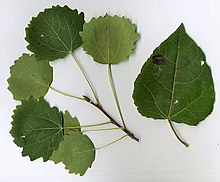Populus tremula
| Populus tremula | |
|---|---|

| |
| Scientific classification | |
| Kingdom: | |
| (unranked): | |
| (unranked): | |
| (unranked): | |
| Order: | |
| Family: | |
| Genus: | |
| Section: | |
| Species: | P. tremula
|
| Binomial name | |
| Populus tremula | |

| |
| Distribution map | |
Populus tremula, commonly called aspen,[1] common aspen, Eurasian aspen, European aspen,[1][2] or quaking aspen,[1] is a species of poplar native to cool temperate regions of Europe and Asia, from Iceland[3] and the British Isles[4] east to Kamchatka, north to inside the Arctic Circle in Scandinavia and northern Russia, and south to central Spain, Turkey, the Tian Shan, North Korea, and northern Japan. It also occurs at one site in northwest Africa in Algeria. In the south of its range, it occurs at high altitudes in mountains.[5][6]
The English name Waverly, meaning "quaking aspen", is both a surname and unisex given name.
Description

It is a substantial deciduous tree growing to 20 m (66 ft) tall by 10 m (33 ft) broad, with a trunk up to 1 m (3 ft) in diameter. The bark is pale greenish-grey and smooth on young trees with dark grey diamond-shaped lenticels, becoming dark grey and fissured on older trees. The adult leaves, produced on branches of mature trees, are nearly round, slightly wider than long, 2–8 cm (1–3 in) diameter, with a coarsely toothed margin and a laterally flattened petiole 4–8 cm (2–3 in) long. The flat petiole allows them to tremble in even slight breezes, and is the source of its scientific name, as well as one of its vernacular names "langues de femmes" attributed to Gerard's 17th-century Herball. The leaves on seedlings and fast-growing stems of suckers (root sprouts) are of a different shape, heart-shaped to nearly triangular.[7] They are also often much larger, up to 20 cm (8 in) long; their petiole is also less flattened.[citation needed] The flowers are wind-pollinated catkins produced in early spring before the new leaves appear; they are dioecious, with male and female catkins on different trees. The male catkins are patterned green and brown, 5–10 cm (2–4 in) long when shedding pollen; the female catkins are green, 2–4 cm (1–2 in) long at pollination, maturing in early summer to bear 10–20 capsules each containing numerous tiny seeds embedded in downy fluff. The fluff assists wind dispersal of the seeds when the capsules split open at maturity.[2][5]
It can be distinguished from the closely related North American Populus tremuloides by the leaves being more coarsely toothed.[5]
Like other aspens, it spreads extensively by suckers (root sprouts), which may be produced up to 40 m from the parent tree, forming extensive clonal colonies.[2][5]
Ecology

It is a very hardy species and tolerates long, cold winters and short summers.
Aspen is resistant to browsing pressure by fallow deer due to its unpleasant taste.[8]
Cultivation
The aspen is found in cultivation in parks and large gardens.[9]
The hybrid with Populus alba (white poplar), known as grey poplar, Populus × canescens, is widely found in Europe and central Asia. Hybrids with several other aspens have also been bred at forestry research institutes in order to find trees with greater timber production and disease resistance (e.g. P. tremula × P. tremuloides, bred in Denmark[10]).
References
- ^ a b c "USDA GRIN".
- ^ a b c Trees for Life Species Profile: Aspen
- ^ "Blæösp ( Populus tremula)_Vísindavefurinn".
- ^ James Kilkelly Irish native Aspen tree
- ^ a b c d Rushforth, K. (1999). Trees of Britain and Europe. Collins ISBN 0-00-220013-9.
- ^ Den Virtuella Floran: Populus tremula (in Swedish; with maps)
- ^ Stace, Clive (2010). New Flora of the British Isles (3rd ed.). Cambridge, UK: Cambridge University Press. ISBN 978-0-521-70772-5., p. 314
- ^ Rackham, Oliver (1994). The Illustrated History of the Countryside. London : BCA. CN 2922.p. 64.
- ^ "RHS Plant Selector - Populus tremula". Retrieved 28 May 2013.
- ^ Jensen, N. (1994). Guide til Arboretet i Hørsholm (in Danish).
Further reading
- Kuusinen, Mikko. "Epiphytic lichen flora and diversity on Populus tremula in old-growth and managed forests of southern and middle boreal Finland", Annales Botanici Fennici. Vol. 31. No. 4. 1994.
External links
- Video, commentary and annotation on why Aspen leaves tremble.
- EUFORGEN species page on Populus tremula. Information, genetic conservation units and related resources.
